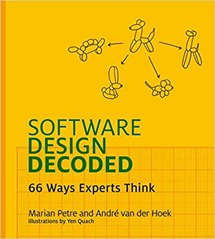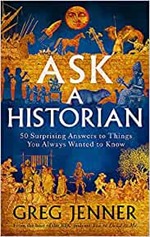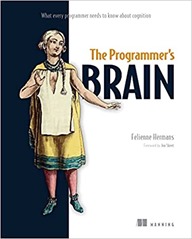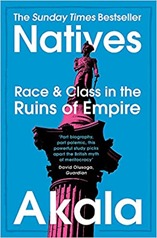 Software Design Decoded: 66 Ways Experts Think by Marian Petre and André van der Hoek is my next read.
Software Design Decoded: 66 Ways Experts Think by Marian Petre and André van der Hoek is my next read.
I picked it up as a recommendation from The Programmer’s Brain by Felienne Hermans. It is an odd little book, something like A6 format with 66 pages containing a short paragraph or two on the behaviours of experts in software design. Each page dedicated to a single thought. There are sketches scattered liberally though the book by Yen Quach who is credited in the author biographies.
Although it does not have a contents page or index, Software Design Decoded is divided into “chapters”:
- Experts keep it simple
- Experts collaborate
- Experts borrow
- Experts break rules
- Experts sketch
- Experts work with uncertainty
- Experts are not afraid
- Experts iterate
- Experts test
- Experts reflect
- Experts keep going
I found this book reassuring as much as anything, and it also gave me some things to think about. Reassuring because it turns out I share habits with expert in software design, which must be a start to being an expert! I write quite a lot of software (for data analysis and data builds) but design tends to come as an afterthought.
I think the things I already do are to build something even if it isn’t the final form, I was interested in the comment about avoiding over-generalisation. The element I am missing here is to learn from this initial form and build something better (potentially discarding what I’ve already done). I also do a fair bit of testing, although in this book testing is wider than just software unit tests or even integration tests, it is about testing preconceptions and testing with the user.
I also liked the comment on focusing on the needs of the key stakeholders where the key stakeholders are the end users, this is a recurring theme – that the end users are the key focus, and them using the product/software are when the job is done.
Always learning gets a recommendation as well as not being afraid to use things in manners other than that intended.
I was interested to note the comments on experts forever sketching since it is something I scarcely do, sometimes a write sequences of tricky bits of code with the odd arrow. I remember learning how to draw flow charts in the late seventies but rarely use the skill (certainly not with all the proper symbols). Software Design Decoded is slightly contradictory on this, in one place experts sketch abstractly as an aid to thought with the sketches meaningless beyond the moment, and in another the sketches are kept for reference later and hence clear and well-labelled.
Notation also gets a couple of mentioned, I take this as a formalised system for naming things – something popular with physicists where the right notation is the difference between a page of formulae and a single line. I’m not really aware of using this in my own practice. Despite repeated attempts at object-oriented design I still tend to be quite “procedural”.
I’m still in the “learning” phase of collaboration, for the first time in a while I’m working on code with other people (and it is a bit of a shock for all concerned), I still can’t abide by meetings but the experts can’t abide some of them (the ones with no direction).
I found this a bit of a “feel good” book, I share at least some of the habits of software design experts! I probably wouldn’t buy it for a personal read but if you have a coffee table in your software company this book would fit right in.

 Ask a historian
Ask a historian

 Index, A History of the
Index, A History of the